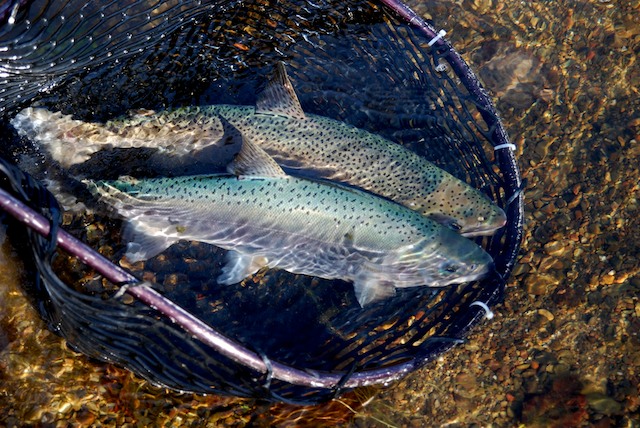
2004 – Present
A comprehensive study of the Salmon Creek Estuary was completed by the Occidental Arts and Ecology Center’s WATER Institute and Prunuske Chatham Inc. in 2006 with funding from the State Coastal Conservancy. The objective of the study was to assess the factors affecting estuarine function and its value as salmonid habitat.
In the fall of 2011, The WATER Institute collaborated with UC Berkeley Ph.D. candidate Cleo Woefle-Erskine to support his research to investigate whether home-scale rainwater harvesting could put more water back in streams like Salmon Creek.

Two high-priority recommendations from the Estuary Study have been implemented:
- Increase summer rearing habitat for juvenile salmonids through installation of large woody structures and floating protective willow mats near the mouth. This project was installed in the spring of 2011. Read our report Habitat Enhancement in The Salmon Creek Estuary to learn more about the project background, goals, process and lessons learned.
- Increase freshwater inflow to the estuary in late spring and summer to improve water quality and lagoon depths for rearing salmonids. A Salmon Creek Water Conservation Program has been started.
Juvenile salmonids migrate from the upper watershed to the lagoon in the late spring and early summer to feed and prepare for entering the ocean in the fall after the estuary breaches. In summer 2004, a severe drought year, the juveniles were trapped in the lower estuary by upstream poor water quality and pool disconnection. During a three-month period (August – October) hundreds of juveniles in the lower estuary disappeared. Predation by seabirds such as seagulls, pelicans, and cormorants is thought to be the cause. This critical rearing area has become significantly shallower in the last 40 years due to high rates of upstream sediment delivery. It is also lacking in protective cover that was once provided by woody debris, small tidal channels and wetlands, and undercut banks.
Recent droughts have created summer streamflow conditions similar to that in 2004. With the reintroduction of coho into the system in 2009, 2010, 2011 and 2012 it is even more critical that the estuary rearing habitat is improved.
Project Partners
Coho Salmon Reintroduced into Salmon Creek
In an effort to reestablish coho salmon within the Russian River basin, the Russian River Coho Salmon Captive Broodstock Program was initiated through a collaborative partnership with the Sonoma County Water Agency, U.S. Army Corps of Engineers, NMFS, CDFG, and others. In 2001, the first wild coho salmon juveniles were collected and reared at Warm Springs Hatchery (NMFS 2010). To improve genetic diversity and the distribution and abundance of coho salmon, captive-reared fish were released into streams within their historic range starting in 2004 (Conrad et al. 2005). Since that time, coho salmon have been released into Russian River tributaries in the fall and spring at select locations.
In 2008, Salmon Creek was selected as an additional release site for captive-reared coho salmon. In December 2008, adults and advanced fingerlings were released into the watershed, and adults were released into the watershed again in December 2009. Releases included captive-reared fish from the Russian River Watershed and Olema Creek, a tributary to Lagunitas Creek in Marin County. The fish were selected from these two strains in an attempt to recreate the likely genetic composition of the historic Salmon Creek fishery.
To record this historic event, the Occidental Arts and Ecology Center’s WATER Institute partnered with Ben Zolno, Jim Coleman and Corby Hines to produce the above video.






